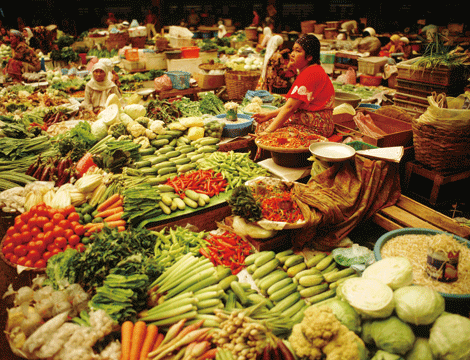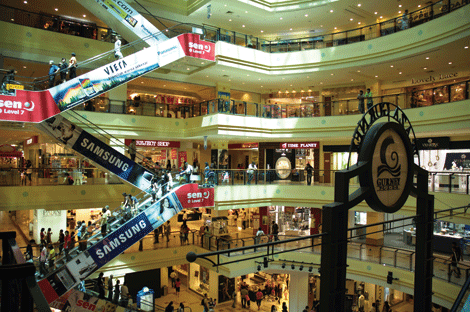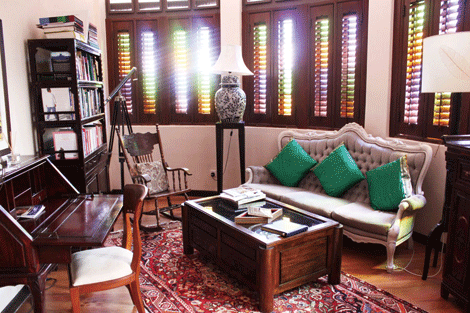Southeast Asia’s third-largest economy is thriving. Export-driven Malaysia has out-performed cautious forecasts, with electronic goods and semiconductor components accounting for more than 50 per cent of exports – and analysts expecting this sector to continue flourishing.
Officials predict palm oil production will increase, with diverse agribusinesses also growing as private sector hunger for new deals intensifies. Other exports include crude oil, liquefied natural gas, rubber, machinery and sundry chemicals. What’s more, the financial services niche is also healthy.
The government spearheads ongoing efforts to boost a growing tourism industry (including business travel and medical tourism) that anchors a significant chunk of the services sector. Besides wooing non-Malaysian visitors, authorities intend wringing bigger bucks from thriving domestic tourism.

Central Market, Kelantan
Malaysia boasts splendid infrastructure: telecommunications spark envy among developed countries while superb highways criss-cross the country. For instance, there’s the North–South Expressway, running along Peninsular Malaysia’s spine, sprouting exits and entrances at every population centre.
Development of secondary cities is promoted, rather than single-minded emphasis on the federal capital, Kuala Lumpur. Indeed, our examination of Kuala Lumpur and several other key hubs suggests this policy greatly benefits the regions, spreading out business decision-making. So, don’t assume that your next Malaysian meetings will inevitably be in Kuala Lumpur – they may well be in another city.
Kuala Lumpur
Peak-hour traffic crawls in stop-start style on freeways at the capital’s edges. But it’s far better than in most places, a Japanese expatriate who’s lived in other regional capitals says. Like others, from elsewhere in the region or beyond, he finds “KL” – as it’s universally called and where 1.8 of the 29 million Malaysians live – an appealing base, with expected big-city amenities but small enough to easily get around. The KL Monorail is handy and taxis are plentiful, particularly at or near hotels.
Many businesses either in the financial sector or involved with Malaysian exports are in or near Bukit Bintang’s hotel zone, along Jalan Sultan Ismail or on Jalan Tuanku Abdul Rahman.
Kuala Lumpur has Malaysia’s liveliest after-dark scene, but tamer than, say, Bangkok’s. Much of it is close to Bukit Bintang’s “golden triangle” where numerous upscale hotels, trendy shopping malls and quality eateries are located. Many restaurants and bars cluster (with oft-changing names and formats) along Jalan Changkat Bukit Bintang, off Jalan Bukit Bintang. A stalwart here for after-work drinks is Little Havana, from where it’s a three-minute walk to Jalan Alor’s night market – one of several precincts with tables spilling onto streets from restaurants and stalls.
What’s new? Kuala Lumpur’s spiffy new 412-room (including 42 suites) Grand Hyatt (www.hyatt.com), centrally located in the business district, welcomed its first paying guests on August 24. Another five-star, Accor’s 513-room Pullman Kuala Lumpur Bangsar (www.pullmanhotels.com), also pitched at the upper end of the corporate market, has had its opening slightly delayed by fine-tuning and now plans to check in its first guests towards the end of the first quarter of 2013. The hotel is similarly well located for meetings; it’s close to the KL Monorail and other public transport options as well as to shopping malls and entertainment. The 281-room Pullman Putrajaya Lakeside (www.pullmanputrajaya.com), in Kuala Lumpur’s futuristic federal capital district, is handy for visitors whose business is with government departments. Overall, the Malaysian capital remains one of the region’s least expensive for accommodation. Industry analysts blame over-building but note this doesn’t seem to faze developers, with several more independent hotels planned.
Movement from suburban to city living is an increasing trend – with traffic-jam avoidance and proximity to restaurants often cited as reasons. This is particularly apparent in and near the Bukit Bintang area, where glitzy residential towers sit cheek-by-jowl with far less opulent buildings.
The Jalan P Ramlee area continues to anchor the nightlife scene, being home to large dance clubs and lively little bars. However, a more mature ambience pervades a nearby competitor: restaurants and bars along Asian Heritage Row (on Jalan Doraisamy, off Jalan Sultan Ismail). Here, historic houses were transformed into one of the capital’s hottest nightlife strips.
Kuala Lumpur residents, domestic tourists and visitors often take short breaks at resorts within an hour’s drive. Two of the best are the over-water Golden Palm Tree (www.goldenpalmtree.com), arguably Malaysia’s most unusual since it is arranged so that it looks like a palm tree from the air and stretches a kilometre out to sea. The other is The Club Saujana Resort (www.theclubatthesaujana–kl.com), adjoining two 18-hole golf courses and a garden-setting spa.
Kuching
There’s plenty of room to swing a cat in Kuching since its population is just 650,000. In fact, there’s no escaping cats in a place often nicknamed “Cat City”. Sarawak’s capital has cat statues by the dozen. What’s more, there’s Cat’s Eye Hill (Bukit Mata Kuching) and even the Kuching Cat Museum which celebrates all felines, Garfield included.
Strolling through “old Kuching”, I see plenty of real cats – but they seem no more or less pampered than cats elsewhere, even if residents regard cats as lucky.
How Kuching got its name remains mysterious. The most common belief is that it is derived from kuching (“cat” in Malay) because a variety of longan fruit called mata kuching (“cat’s eye”) thrived here.
Sarawak is one of two Malaysian states – the other being Sabah – which are located on Borneo island rather than on Peninsular Malaysia itself. Kuching is a pleasant and unhurried city where traffic moves smoothly except for brief peak-hour delays. Delays may be comparatively short compared to much of Asia, but they’re enough to annoy the locals.
Main attractions close to town include Semenggoh Wildlife Rehabilitation Centre, where orangutans swing from surrounding jungle to guzzle fruit on a platform, and Bako National Park where skittish proboscis monkeys with ridiculous noses are eyeballed. Downtown, the elaborately decorated Tua Pek Kong Chinese temple is on most itineraries. Kuching is a good starting point for travellers heading into Sarawak’s hinterland to stay in tribal longhouses.
While taxis are plentiful, downtown is compact – meaning walking to meetings is practical. Preserved architectural gems include British colonial structures and old Chinese shophouses. High-rise offices (housing outposts of companies involved in key exports and related service industries), shopping malls and upscale hotels stand next to quainter “old Kuching”, which mainly occupies narrow streets leading from the city’s broad boulevards.
Top hotels include the centrally located Hilton (www.hilton.com) and the newer Pullman (www.pullmanhotels.com). Also popular with business travellers is Four Points by Sheraton Kuching (www.starwoodhotels.com) because of its convenient location for meetings. Other options include parkland-setting Merdeka Palace (www.merdekapalace.com) and riverfront Grand Margherita (www.grandmargherita.com).
Good restaurants are plentiful but nightlife is mostly about karaoke, youth-oriented live music venues and a few dance clubs in what is generally an early-to-bed city. For a quick calorie-laden dip into Sarawak culture, with its large traditional tapestry on one wall, head to The Dayak, renowned for local cuisine and favoured for business entertaining. Among its ice cream choices are scoops including local rice wine called tuak.
What’s new? A growing trend is moving house to developments nearer downtown, such as affluent areas in and around Jalan Ong Tiang Sui. Commuting time, as well as closeness to restaurants and entertainment are often mentioned as motivators. New apartments and refurbished structures in “old Kuching” are bringing a new after-dark vibrancy to the city.
Kota Kinabalu
A common first impression of Kota Kinabalu is that it feels less like a city than Kuching and more like a big frontier town, despite its population of 630,000. Business travellers often opt for resort settings rather than typical downtown business hotels.
Sabah’s capital has plenty going for it. Don’t be fooled by its superficial somnolence: in one week I was caught in four traffic jams. Residents describe daily peak-hour snarls as mercifully brief – but it’s sensible to schedule a meeting for off-peak times.
Formerly lumber dependent, Sabah has diversified. Manufacturing, including timber products such as plywood, is economically important. So is aquaculture (particularly lobster breeding and seaweed production), agriculture (encompassing palm oil plantations), oil and gas and tourism. Export of raw lumber is banned to save rainforests but environmentalists complain land is still cleared for palm oil cultivation.
Diversions include Kinabalu National Park hikes, Mount Kinabalu climbs, Poring Hot Springs soaks, jungle canopy walks and tribal community visits – along with activities such as diving near Sabah’s second city of Sandakan, which also offers viewings of orangutans and proboscis monkeys along with cruises up jungle-edged Kinabatangan River. Some companies arrange treks from Kota Kinabalu and Sandakan along the route of World War II’s Sandakan Death Marches (when 3,600 Indonesian labourers and 2,400 Allied prisoners died).
Among resort-style hotels is the Sutera Harbour Resort (www.suteraharbour.com), a sprawling 155-hectare property attracting a mix of tourists and business travellers. Its two hotels are the business-oriented Pacific Sutera and leisure-focused Magellan Sutera – together they boast 956 rooms. Alternatives are the 492-room Shangri-La Tanjung Aru and 416-room Shangri-La Rasa Ria (www.shangri-la.com), 485-room Nexus Resort & Spa (www.nexusresort.com) and the older, but totally refurbished, Hyatt Regency (www.hyatt.com) in the heart of the city.
Kota Kinabalu’s biggest event is its weekly Gaya Street Sunday Market when a busy city street is closed, allowing locals and visitors to throng one of Southeast Asia’s biggest markets. Goods sold include food, fabrics, plants, pets and many other items including handicrafts and sundry souvenirs.
Kota Kinabalu’s night scene is much like Kuching’s; not nearly as lively as Kuala Lumpur’s and highlighted by karaoke, a few dance clubs and live music venues.
What’s new? The most recently built top-drawer hotel is the 306-room Le Meridien (www.starwoodhotels.com), overlooking markets and the South China Sea. Centrally located in the commercial area, it opened seven years ago. As is the case in much of Malaysia, the Kota Kinabalu area is over-built with hotels, so rates remain low and discounts are common. Developers are more wary here than in other major Malaysian cities.
A top entertaining outlet for business is Coast at Shangri-La Rasa Ria, recently refurbished and highly regarded by residents – showcasing memorable Chinese and Malay fare. An alternative, similarly earning locals’ praise, is Grazie (www.grazierestaurantkk.webs.com) with Italian cuisine, which has also recently been renovated.
Penang

Gurney Plaza, Penang
Penang, Malaysia’s second-smallest state, punches above its weight, producing one quarter of national exports. Highly urbanised, it concentrates on manufacturing and services – particularly high-tech products. Dell, Motorola, Sony and Intel have factories here, as does B. Braun, a multinational medical products manufacturer.
Tourism is important, with large resorts strung along Batu Ferringhi’s strip. However, discerning visitors increasingly stay in the capital, Georgetown.
Local officials like to say Penang works exceptionally successfully. Traffic is an indicator of this, slowing briefly at peak hours but otherwise moving well.
Penang’s nightlife is nowhere near as lively as KL’s. The Gurney Drive coastal esplanade, a brightly lit nocturnal restaurant strip, prompts residents’ complaints that tourism-driven prices are higher than modest Malaysian norms – so they often prefer the so-called Chinatown precinct where Lebuh Chulia has a similar “touristy” reputation but Lebuh Kimberley is more authentic and lower priced, with fewer signs in English.
What’s new? Georgetown: the old is new again. However, it still oozes history; World Heritage-listed, it’s often described as Asia’s best-preserved showcase of colonial era architecture. Increasingly, it’s the first choice for informed visitors.
Georgetown houses 1.25 million people. Conversion continues of dilapidated 19th century shophouses and mansions into top-end boutique hotels, one of the best being six-suite Clove Hall (www.clovehall.com). Set in a tropical garden, it fuses Malay, Chinese and European influences. In similar vein are the 11-suite Campbell House (www.campbellhousepenang.com), a grandly refurbished blending of Malaysian and Italian influences, and the six-room Yeng Keng Hotel (www.yengkenghotel.com.my) which incorporates more old-China décor.

Campbell House, Penang
Far bigger than this trio, one of Asia’s grand old hotels has been gutted and restored. The formerly faded Eastern and Oriental Hotel (www.eohotels.com) has been reborn as a wonderful all-suite property of the same name. The hotel’s elegant 1885 Restaurant – that was named after the year of the hotel’s opening – combines Western and Malaysian classics and is arguably Georgetown’s number one choice for business entertaining. English afternoon tea in the 1885 is a stylish option.
Apartment buildings near historic Georgetown’s edges indicate a trend common to many Malaysian cities: a desire to live close to town because of traffic and availability of amenities.
AIRPORTS
Kuala Lumpur International Airport (KLIA) is 75km from downtown, a national showpiece and Malaysia’s number one airport. Though one of Asia’s best, it’s also one of the region’s least crowded because it hasn’t yet become a facility that is on everyone’s lips, as is intended. More crowded, using the same runways but on the airport’s other side, is the Low–Cost Carrier Terminal (LCCT), 58km from downtown with its own restaurants and shops. Dominated by fast-expanding Air Asia (including the long-haul arm Air Asia X), the LCCT has become so busy that a replacement is being built nearby to open next year. From its LCCT base, Air Asia serves 75 destinations in Asia and Australia. When the new facility is operational, it will be mainly, though not exclusively, for low-cost carriers and known as KLIA2, with the present-day KLIA referred to as KLIA1.
Kuching International Airport is 11km from downtown, and is a comfortable and modern facility with the usual range of shops and restaurants. Its international flights go to Brunei, Hong Kong, Singapore and Pontianak in Indonesia. Domestic services operate to Peninsular Malaysia and Sabah, as well as within Sarawak. The terminal in its present form opened six years ago. It was a radical extension and refurbishment of a former facility. Further renovations were completed in 2008 and the government is considering additional extensions.
Kota Kinabalu International Airport, located 8km from the city centre, is Malaysia’s second busiest after KL. It has international flights to Brunei, Shenzhen in China, Hong Kong, Indonesia, the Philippines, Singapore, South Korea and Thailand. Domestic services take off for Peninsular Malaysia and Sarawak, as well as to points within Sabah, including Sandakan. Of two terminals, the refurbished Terminal 2 is mainly for low-cost carriers. The five-year-old Terminal 1 meanwhile features décor styled after a wakid (traditional basket). Both terminals are modern with plenty of shops and eateries. Twenty-four hour operation was resumed this year after six years of nightly six-hour closures to improve and extend runways, now capable of handling Airbus A380s and the new Boeing 747–8.
Penang International Airport, which lies 16km from the town is Malaysia’s third busiest, and is currently at the end of a head-to-toe renovation, but remains efficient. Flights currently go to China (Guangzhou, Nanning, Shenzhen), Indonesia (Jakarta, Banda Aceh, Medan and Surabaya), Japan, Taiwan, Thailand (Bangkok and Phuket), Singapore and Vietnam, as well as to domestic destinations. The large 35-year-old terminal has been upgraded and extended several times. The latest work has resulted in more aircraft bays, boarding gates, baggage carousels, immigration counters and parking. Funds have been allocated for a separate low-cost carrier terminal which, when operational, will reduce crowding in the main shared building since the low-cost niche is growing rapidly both domestically and internationally.
Chris Pritchard








